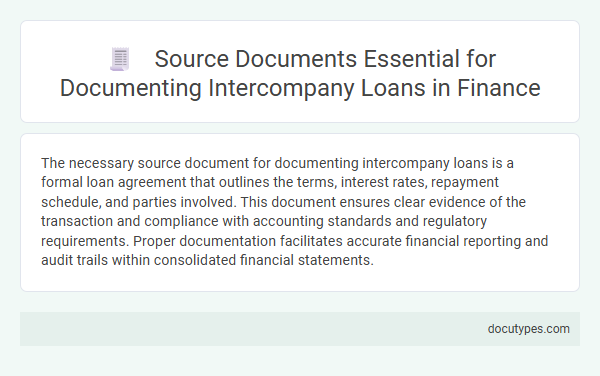The necessary source document for documenting intercompany loans is a formal loan agreement that outlines the terms, interest rates, repayment schedule, and parties involved. This document ensures clear evidence of the transaction and compliance with accounting standards and regulatory requirements. Proper documentation facilitates accurate financial reporting and audit trails within consolidated financial statements.
Introduction to Intercompany Loan Documentation
Intercompany loan documentation is essential for maintaining clear financial records between related entities within a corporate group. A promissory note or loan agreement serves as the primary source document, outlining the terms and conditions of the loan, including interest rates and repayment schedules. Proper documentation ensures compliance with regulatory requirements and supports accurate financial reporting.
Importance of Source Documents in Intercompany Loans
Source documents are essential for accurately recording intercompany loans, providing verifiable evidence of the transaction between related entities. These documents include loan agreements, promissory notes, and approval records, ensuring transparency and compliance with accounting standards.
The importance of source documents lies in their role in validating the loan terms, interest rates, and repayment schedules, which is critical for internal controls and audit processes. Proper documentation reduces the risk of disputes and financial misstatements, supporting regulatory compliance and tax reporting. Maintaining detailed source records facilitates clear financial reporting and strengthens the integrity of intercompany transactions.
Loan Agreements: Key Components and Formats
| Source Document | Loan Agreement |
|---|---|
| Purpose | Official record detailing terms and conditions of the intercompany loan |
| Key Components |
|
| Formats |
|
| Importance | Ensures transparency, proper accounting recognition, tax compliance, and audit readiness related to intercompany financing |
Board Resolutions and Approvals
Documenting intercompany loans requires precise source documents to ensure legal and financial compliance. Board resolutions and approvals stand as crucial evidence supporting the authorization and terms of these loans.
- Board Resolution - This formal document captures the approval from the board of directors authorizing the intercompany loan.
- Approval Documentation - Written approvals confirm that the necessary parties have consented to the loan conditions and amounts.
- Loan Agreement Reference - The resolution often references or attaches the loan agreement, detailing the terms and repayment schedule.
Evidence of Fund Transfers: Bank Statements
Documenting intercompany loans requires clear evidence of fund transfers to ensure accuracy and compliance. Bank statements serve as a critical source document providing proof of these financial movements between entities.
- Verification - Bank statements confirm the exact dates and amounts of funds transferred between intercompany accounts.
- Audit Trail - These statements establish a transparent record for auditors to trace the loan transactions.
- Reconciliation - Bank statements help reconcile the lender's and borrower's financial records, maintaining consistency across reports.
You must retain these bank statements as essential evidence when documenting and verifying intercompany loans.
Interest Calculation and Payment Records
Intercompany loans require a formal loan agreement as the primary source document for documenting the terms and conditions, including interest rates. Interest calculation must be clearly outlined within this agreement, supported by amortization schedules or interest payment tables. Your payment records, such as bank statements and repayment vouchers, serve as essential proof for interest payments and principal repayments, ensuring transparent financial reporting.
Amortization Schedules and Repayment Plans
Documenting intercompany loans requires a detailed source document that clearly outlines the terms of the loan, including principal amount, interest rate, and repayment schedule. Amortization schedules are essential as they provide a structured breakdown of principal and interest payments over the loan period, ensuring accurate financial tracking.
Repayment plans serve as a formal agreement specifying payment timelines and amounts, helping to maintain transparency and compliance with accounting standards. Proper documentation of these elements supports audit trails and facilitates effective intercompany financial management.
Compliance Documents and Regulatory Filings
Intercompany loans require precise source documents to ensure transparency and compliance with financial regulations. Compliance documents such as loan agreements and promissory notes are primary records that outline terms and conditions.
Regulatory filings, including transfer pricing documentation and intercompany loan disclosures, are essential for adherence to tax laws and audit readiness. You must maintain these documents to support accurate financial reporting and regulatory compliance.
Communication Records between Related Parties
What source document is necessary for documenting intercompany loans? Proper communication records between related parties are essential to establish the terms and conditions of intercompany loans. These records may include emails, memos, or formal loan agreements that detail repayment schedules, interest rates, and authorization approvals to ensure compliance with financial regulations and audit requirements.
What Source Document Is Necessary for Documenting Intercompany Loans? Infographic

